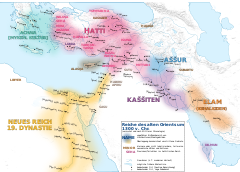Amarna Period
In the history of ancient Egypt and the ancient Near East, the term "Amarna period" serves to designate a period of the Late Bronze Age there, encompassing the 14th and 13th centuries BC. In Egypt, it includes the reigns of the kings (pharaohs) Akhenaten and Semenchkare. Akhenaten had founded a new capital (Achet-Aton) in his 6th year of reign near today's Tell el-Amarna (Amarna) in Middle Egypt and worshipped a sun god, Aton, as the only god and persecuted the memory (in pictures and inscriptions) of other deities, especially that of the old imperial god Amun. Akhenaten thus broke radically with many of Egypt's ancient traditions. There are also many innovations in art. The death of the ruler and the following period are still unclear in many aspects, but there seems to have been civil war-like conditions. Only under Haremhab stabilized conditions occurred.
This period is named after the Egyptian site Tell el-Amarna mentioned above. There, since the early 1890s, fellahs have found an archive of some 400 clay tablets documenting parts of the political correspondence of kings Amenophis III, Akhenaten and Tutankhamun between about 1358 and 1330 BC. Since the political system reflected by this correspondence extended from the 15th to the end of the 13th century BC, the term "Amarna period" is now anachronistically applied to this entire era.
The diplomatic system, also called the "Club of the Great Powers" or the "Club of the Great Kings", extended in its east-west expansion from western Iran to the Aegean and in its north-south expansion from Anatolia to Nubia. This system was supported by Cassite Babylonia, the Hittite Empire and Egypt, which lasted throughout the entire epoch. In northern Mesopotamia there existed at first the Mitanni Empire, which was replaced from the middle of the 14th century by the rising Middle Assyrian Empire. The eastern fringe was formed by the kingdom of Elam, the western fringe was marked by Keftiu (Crete) and Tanaja (Peloponnese or the entire Mycenaean-dominated Greek mainland) in Greece. In addition to these great states, a large number of city-states existed, especially in Syria and Palestine, which were in changing relationships of dependence to the great powers.

Geopolitical situation in the Levant during the first half of the 14th century BC.

Geopolitical situation during the 13th century BC.

Clay tablet EA 161 from the Amarna archive, which gave the name to the epoch
Art
In the Armana period, the so-called Amarna art prevailed in large parts of Egypt. Here, people were painted in softer features, with round bellies and with overlong necks and faces.
The relief of Nefertiti and Akhenaten, for example, is one of the most important works of this period.
Questions and Answers
Q: What was the Amarna period?
A: The Amarna period was an era of Ancient Egypt in the last half of the Eighteenth dynasty.
Q: Where was the royal residence of the pharaoh and his queen during the Amarna period?
A: The royal residence of the pharaoh and his queen was shifted to Akhetaten in what is now Amarna.
Q: Who was the pharaoh during the Amarna period?
A: The pharaoh during the Amarna period was Amenhotep IV, who changed his name to Akhenaten.
Q: What change did Akhenaten make in Egypt's religion during his reign?
A: Akhenaten changed Egypt's polytheistic religion into one where the sun disc Aten was worshipped over all other gods.
Q: Was the religion during Akhenaten's reign monotheistic?
A: No, the religion during Akhenaten's reign was not monotheistic as other gods were worshipped to a significantly lesser degree.
Q: How did royal portraiture change during Akhenaten's reign?
A: Sculptures of Akhenaten are different from those of earlier pharaohs. Akhenaten is shown in an androgynous and stylized manner, with large thighs, a slim torso, drooping belly, full lips, and a long neck and nose.
Q: What is unclear about the events following Akhenaten's death and his co-regent and immediate successor Smenkhkare?
A: The identity and policies of his co-regent and immediate successor Smenkhkare are unclear, as are the events following Akhenaten's death.
Search within the encyclopedia